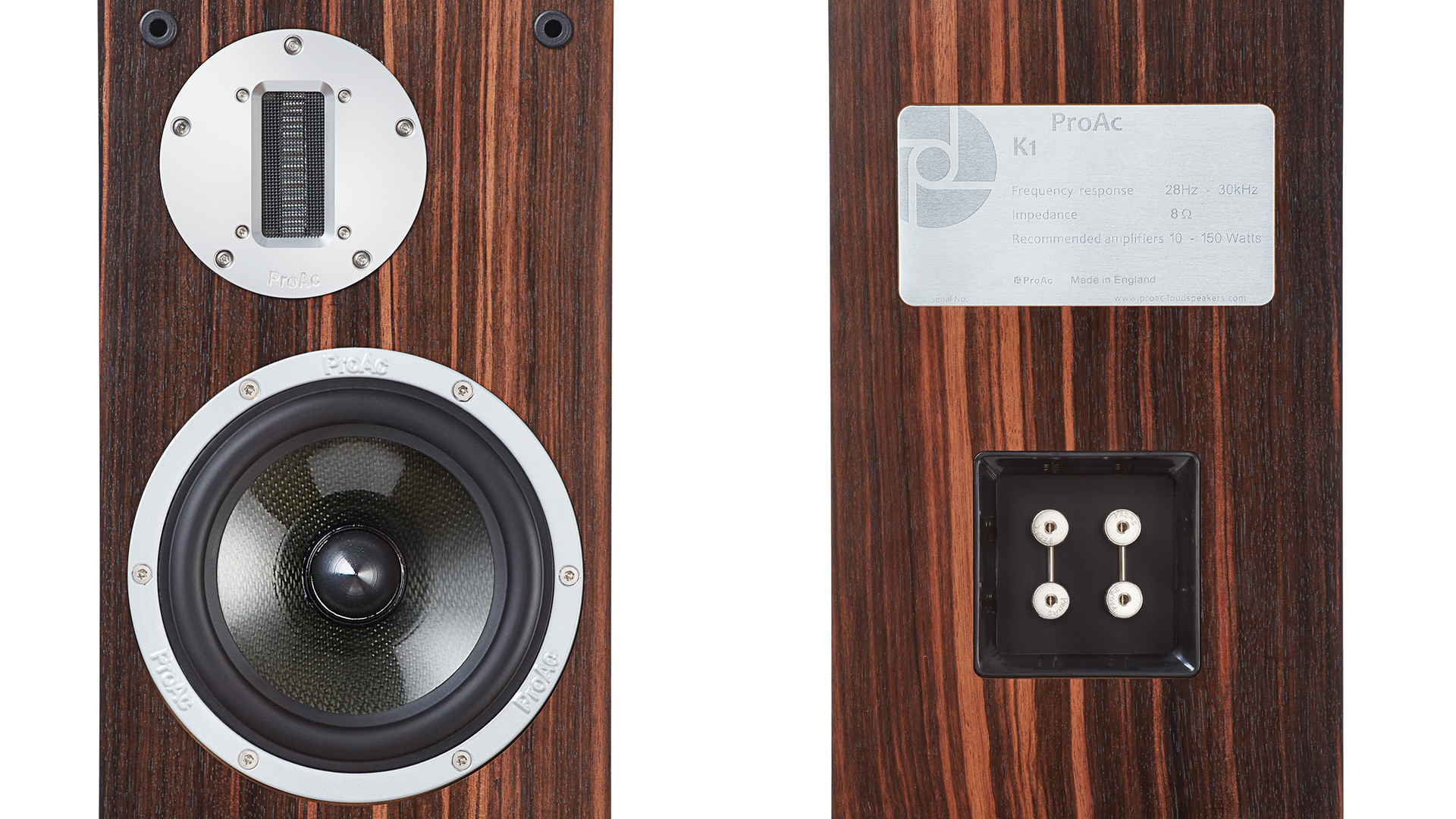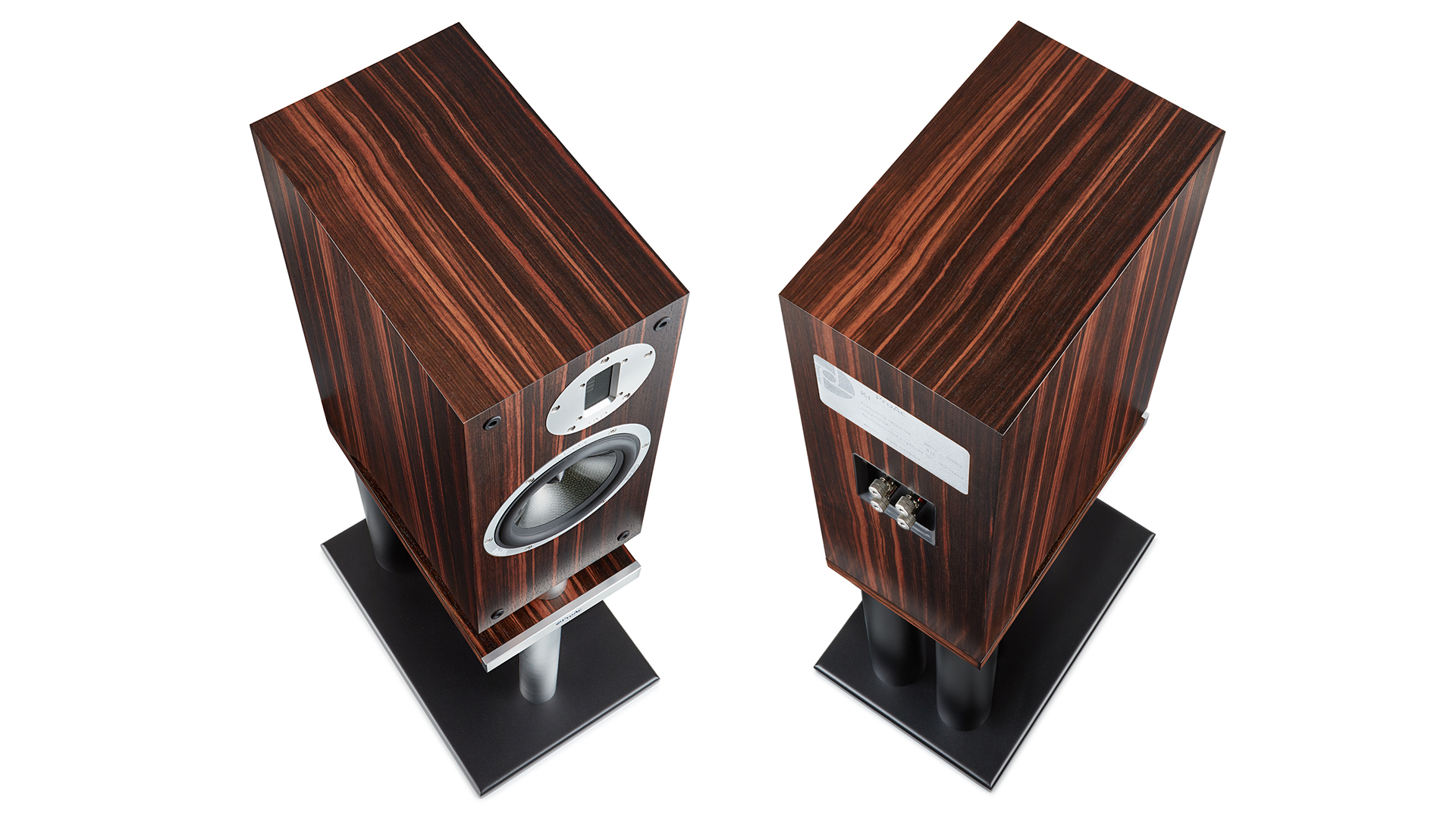What Hi-Fi? Verdict
ProAc’s K1 offer a deeply satisfying listen with an emotive midrange and musical cohesion that rivals can’t match
Pros
- +
Natural and insightful midrange
- +
Expressive dynamics
- +
Composed nature
Cons
- -
Optional stands are pricey
- -
Tough competition
Why you can trust What Hi-Fi?
ProAc’s high-end K series has been in production for 12 years now. The speakers in the range have evolved and been improved in that time, of course, but they have always been floorstanders. Until now that is.
ProAc says there was a growing demand for a flagship standmount option and it was happy to oblige. The company isn’t known for rushing the development of new products, so it comes as no surprise that it has taken years for the K1 to make their way into production.
Build

On first viewing, these speakers have a slightly odd appearance, courtesy of an unusual plinth arrangement that echoes the design of the various K series towers. While it works well visually on the floorstanders, such a look takes a little acclimatisation when transferred to a much shorter standmounter.
This arrangement allows for a downward-facing port and gives a known fixed boundary (the plinth) for the port to fire on. Without that boundary, the speaker designer is left to guess at the available space between the port and any surface it fires onto, which naturally leads to less precise port tuning. A downward-firing port should also make the speakers a little less fussy about room placement than a typical rear-firing alternative would be.

Impedance 8 ohms
Frequency response 28Hz-30KHz
Sensitivity 90dB
Finishes x6 (standard), x4 (premium)
Dimensions (hwd) 57 x 26 x 40cm
Weight 16kg (each)
The K1’s overall build quality is as good as the price demands. The cabinet is neatly made in general, with nice crisp edges and a lovely real wood finish. ProAc has gone for High Density Fibreboard (HDF) panels all round, but with different thicknesses to spread resonances. These panels are carefully damped with bitumen to control those resonances and the result should be a quiet, but rigid, cabinet.
There are six standard finishes options: black ash, mahogany, cherry, natural oak, silk white and walnut. But if those don’t suit you can choose to have rosewood, ebony, tamo ash or dark eucalyptus for a premium of £900 ($1000, AU$1400). There’s no doubt these are solidly made speakers that have been assembled with great care, but there are a couple of cosmetic niggles.
While no one will see the plinth’s bottom surface once the speakers are on stands, it’s a shame that ProAc didn’t cover the base with veneer or give it some other treatment to make it look smarter. Currently, it looks a little unfinished with the plain wooden panel visible. This feels like cost-cutting that has no place in a product such as this. The way the plinth’s metal front plate is attached looks a little messy from underneath, too. Neither of these things are major issues, but at this price level, such small details matter.
The latest hi-fi, home cinema and tech news, reviews, buying advice and deals, direct to your inbox.
ProAc makes 50cm-tall dedicated stands for the K1 that cost £995 ($1995). They require assembling and are held together by an oddly varied collection of screws and bolts. There are four columns in total for each stand and, thanks to pretty clear instructions, it doesn’t take long to put them together. The silver one in the front is solid aluminium (matching a similar piece on the front of the speaker), while the remaining three (all painted black) are hollow steel tubes. Once assembled, the stands are quite resonant, so a bit of mass-loading with sand or similar would help.
These stands still do the job of supporting the speakers well, enabling the K1’s presentation to have a good sense of space and dynamic subtlety. Things aren’t perfect, though: they lack the precision-engineered feel we would expect from something selling at this price, and we also find that the supplied floor spikes are hard to lock in place and come loose easily over time.
It wouldn’t take anything more than a conventional set of hexagonal lock nuts that can be tightened by a spanner to fix the issue. We can’t understand ProAc’s decision to use round lock nuts that can only be finger-tightened instead. A small point, but annoying all the same.
Compatibility

But enough of stands and cosmetic issues, it’s in the sonic engineering where these speakers ultimately prove their worth. The K1 are a two-way design that makes use of ProAc’s well-proven ribbon tweeter with its machined faceplate, damped rear chamber and Alnico magnet assembly. We’ve heard this tweeter in other ProAc models and it has always impressed with its high levels of insight and refinement.
Here, it’s combined with a rather esoteric-looking 16.5cm Kevlar mid/bass unit, which is based on the one used in the larger K3 floorstanders. Various aspects of the driver have been tweaked to account for the differing technical needs of the two speakers.
A high-quality, carefully calibrated crossover blends the two drive units and results in a reasonably high sensitivity of 90dB/W/m and 8ohm nominal impedance. ProAc tends to make speakers that are relatively kind loads for amplifiers to drive and this one appears to be no different.
That isn’t an excuse to skimp on the partnering electronics, though. As the price level demands, these are highly revealing speakers that will show up any shortcomings in the signal chain that feeds them.
Such is the K1’s sonic quality, we suggest being as ambitious as you can. They sound right at home at the end of our reference Naim ND555/555 PS DR music streamer and Burmester 088/911 Mk3 amplifier combination, which together costs around ten times as much as the speakers themselves.
We also have our usual Technics’s SL-1000R/Kiseki Purple Heart MC record player to hand, as well as Chord’s DAVE DAC/Ultima 5 digital controller/power amp combo, just to see how these standmounters cope with different sonic signatures.
Sound

Ask us to describe the K1’s sound in one word, and we’d pick ‘musical’. With a bit more leeway on the word count, we might add ‘expressive’, ‘cohesive’ and ‘comfortable’. The latter isn’t a term we use often when describing the sound of a product, but it fits these standmounters perfectly.
These are the kind of speakers that you can listen to for hours on end without feeling fatigued. They have a calm disposition that makes it easy to relax and just concentrate on the music. But don’t mistake calmness for boring – that simply isn’t the case here.
We play Seven Nation Army by The White Stripes and the K1 respond with enthusiasm. They deliver the hard-charging beat with verve, rendering those grungy bass notes with punch and power. Rivals such as the KEF Reference 1 certainly deliver more in the way of outright muscularity, but these ProAcs hardly sound lacking on their own terms. That bass dovetails into the midrange seamlessly leaving the K1 to exhibit a top-to-bottom consistency that only Spendor’s excellent Classic 1/2 come close to emulating.
The midrange is the K1’s crowning achievement, an ideal combination of articulation, dynamic expression and natural warmth. Voices sound so organic and convincingly textured. It doesn’t matter whether it’s Jack White or Nina Simone, these speakers are supreme at communicating the passion in the performance.
Familiar songs such as Simone’s Strange Fruit bring a chill as she describes the horrific events in the US deep south. It’s one thing that a speaker is clear enough to make words easy to understand – every credible competitor at this price does that – but it’s something else entirely to make the vocalist’s emotion so easily accessible and understood. That’s something these ProAcs do with class-leading skill.

There are similarly priced rivals that arguably dig up even more information than the K1, but we can’t think of any that organise the detail in a more convincing or enjoyable manner. The result is that voices and instruments simply sound more authentic and believable.
These ProAcs treat all genres of music equally, too. During the test process, we try everything from Stravinsky’s The Rite Of Spring through to Kanye West’s My Beautiful Dark Twisted Fantasy, with the likes of Bruce Springsteen’s Ghost Of Tom Joad set in between, and these standmounters never fail to shine.
Positioned with care, well away from all walls and with a touch of angle towards the listening position, they also image with precision. It’s important to sit with your ears in line with the tweeter's height for optimal results, as ribbon drivers tend to be more focused with their vertical dispersion than conventional dome tweeters. There’s more room to play around with the toe-in angle.
The KEF Reference 1 edge ahead when it comes to stereo imaging, showing more in the way of consistency as we move away from the listening sweet spot, but these ProAcs are at least on a par with the best of the rest.
Tonally, the K1 are smooth at the top-end and a little rich through the midrange and bass. They have been artfully balanced to sound unfussy and entertaining without going so far as to distract. The fact that they perform so well with so many different types of recordings shows just how skilful ProAc’s engineers have been in striking an accommodating balance.
Verdict
This is a tough part of the market to crack, with exceptional performers available from almost every major speaker manufacturer. We counted five-star reviews for the likes of the Audiovector R1 Arreté, Bowers & Wilkins 805 D3, Fyne Audio F1-8, JBL L100 Classic, KEF Reference 1 and Spendor’s Classic 1/2 in just the last few years. There’s something to please every taste here, and it’s hard to go wrong with any of them.
Yet, the ProAc K1 still manage to stand out among such talent. These aren’t necessarily the very best in one specific area – though we do love their wonderful midrange – but they still deliver a balance of sound that is utterly spellbinding in the right system. ProAc may have waited 12 years to release a K series standmounter, but that wait was well worth it.
SCORES
- Sound 5
- Compatibility 5
- Build 4
MORE:
Read our guide to the best standmounter speakers
Read our Fyne Audio F1-8 review
Read our KEF R1 review
Read our Spendor Classic 1/2 review
What Hi-Fi?, founded in 1976, is the world's leading independent guide to buying and owning hi-fi and home entertainment products. Our comprehensive tests help you buy the very best for your money, with our advice sections giving you step-by-step information on how to get even more from your music and movies. Everything is tested by our dedicated team of in-house reviewers in our custom-built test rooms in London, Reading and Bath. Our coveted five-star rating and Awards are recognised all over the world as the ultimate seal of approval, so you can buy with absolute confidence.


